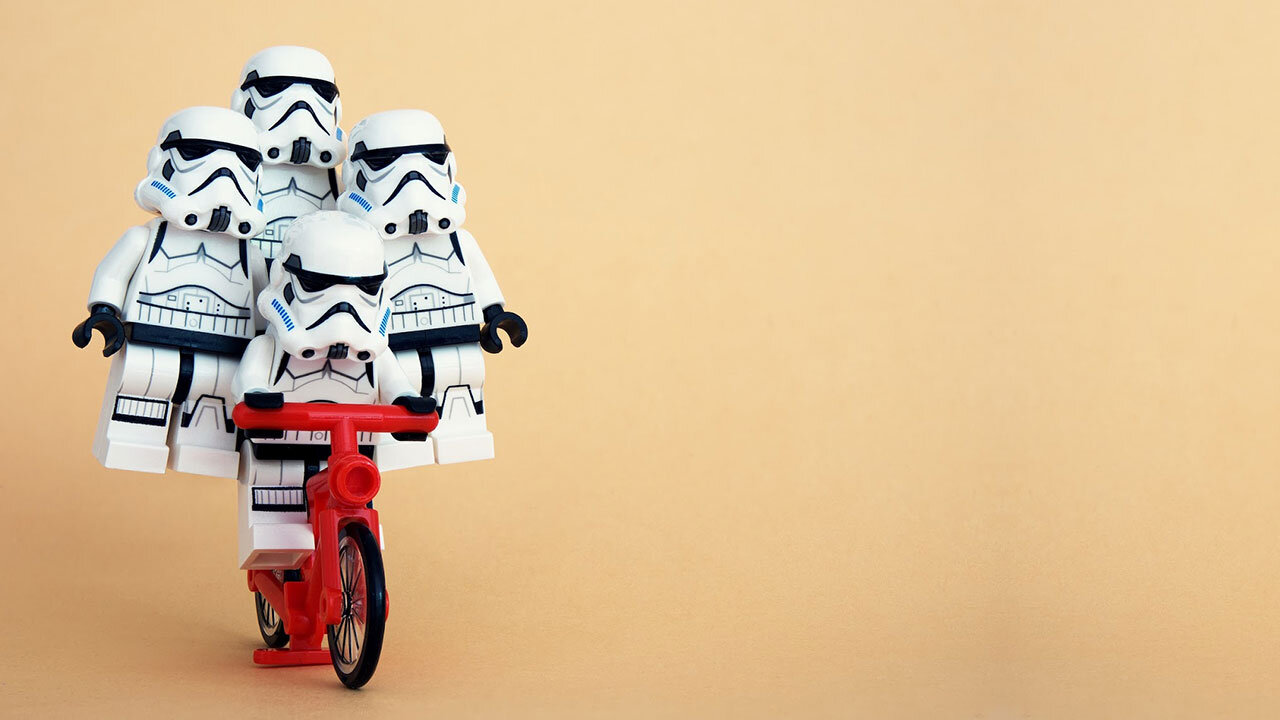Built On Hope: Marketing Lessons from George Lucas and Star Wars

Did you know the correct quote is actually “No, I am your father”?
We didn’t have to name the movie, but it’s probably right in your mind now – Star Wars Episode V: The Empire Strikes Back. The “I am your father” scene is one of the most iconic in franchise history, and it’s a testament to the recall power of Star Wars that just five words are instantly recognizable.
(Look it up, though – Darth Vader doesn’t say “Luke.”)
The first movie released in 1977, titled only Star Wars. It’s impossible to think of today, but the film debuted in less than 32 theatres on a Wednesday night. 20th Century Fox didn’t have high hopes for its opening, since Star Wars was considered the “B side” to the big summer hit The Other Side of Midnight.
But come May 1977, Star Wars broke box office records and became one of the first true blockbuster films. It started a cultural movement that spawned merchandise, spin-offs, theme parks, and parodies. And the global strength of the brand is, in part, down to the fantastic marketing of a space opera with robots and laser swords.
So – how did Star Wars market its franchise so successfully?
A New Hope: Marketing from 1977 to Now
The Star Wars franchise consists of three trilogies – a set of three films released in succession, with continuing stories. Each has had its own marketing strategies ahead of release.
The original trilogy
Given that Star Wars was premiering as an original story, there was only moderate fanfare ahead of its very first release. 20th Century Fox provided limited support. The production company only licensed t-shirts and posters, so marketing director Charles Lippincott had to get creative.
Lippincott secured deals with Marvel for a comic adaptation and Del Rey Books for a novelization. He also used his contacts to promote the film at San Diego Comic Con.
In the beginning, a measly 37 theatres were set to feature the film across all of North America. Thankfully, Fox stepped in and required theatres to show Star Wars if they wanted the screening rights for the much more highly-anticipated movie, The Other Side of Midnight.
However, neither Fox nor George Lucas could anticipate how explosive the film would be. It was an enormous success, and only grew during its subsequent re-releases. The creative team renamed the movie “Episode VI: A New Hope” in 1981, which Lucas has stated would make the audience feel they’d missed something about the story – and would make them come back for more.
Launch of the prequels
The second trilogy to launch in the Star Wars franchise was the “prequel” trilogy – so named because the plot revolved around the story before the events of the originals. Marketing for the prequels – specifically The Phantom Menace – began after the theatrical re-release of the original trilogy with “updated” CGI effects.
The movie’s marketing department also acquired promotional licensing deals with Hasbro, Lego, and PepsiCo to advertise the movie. Meanwhile, Lucasfilm itself organized a Star Wars Celebration event in Colorado in partnership with the Star Wars fan club.
To pique fans’ interest, the studio released a teaser trailer – but not through conventional means. Instead, some theatres would release the teaser after the billed movie had finished screening. Some people would even pay full admission at a cinema just to see the teaser. The hype grew so big that when the full trailer was released, the film’s official website crashed due to server overload.
When teaser posters for The Phantom Menace released, the image called back to Darth Vader, with Anakin Skywalker’s shadow forming the iconic villain’s silhouette.
The new Jedi story
The most recent trilogy had the luxury of a large marketing budget thanks to the enormity of the Star Wars brand. This allowed Disney and Lucasfilm to experiment with their strategies and use several concurrent ones to promote the films.
For The Force Awakens, Lucasfilm put out an 88-second teaser that generated 58.2 million views in its first week on YouTube. Critics reacted favourably, saying it felt very “classic Star Wars.” The next trailer dropped at the Star Wars Celebration in California, to staggering reactions from the audience – and 88 million views within the first 24 hours.
Disney went with drip marketing for the movies, releasing content a little bit at a time. Vanity Fair first released an exclusive cover, then SDCC featured a behind-the-scenes look. The posters hinted at plot points without revealing anything significant.
Ahead of the final installment, The Rise of Skywalker, the director and the studios issued a full marketing blackout. There were no teasers or promotions until the title reveal at the Star Wars Celebration in Chicago. After that, Disney used red herrings in marketing to keep fans guessing about the plot until the film’s debut.
Best of Star Wars Marketing Strategies
There are many film franchises that have become blockbuster hits, and there are others that have stood the test of time. But very few franchises have both the brand success and longevity of Star Wars – and that is, in part, down to its fantastic marketing.
#1 — May the 4th Be With You
It’s like a cosmic alignment in the universe – one of your franchise’s most famous quotes just happens to sound like a date. The Jedi saying of “May the Force be with you” has been transformed into the punny “May the 4th be with you” – now known around the world as Star Wars Day.
The first recorded use of the phrase was on May 4, 1979, when Margaret Thatcher was elected as UK Prime Minister. The phrase’s appearance in the digital sphere came in 2008, with the first Star Wars fan groups on Facebook began coming together. They would use the same catchphrase to celebrate Luke Skywalker Day.
Eventually, both Lucasfilm and Disney embraced the pun as an annual celebration of the franchise.
“May the 4th be with you” is now so popular that every May 4, brands everywhere hop onto the Star Wars train. You have Starbucks, Nissan, and even the PGA putting out #MayThe4thBeWithYou tweets. The hashtag trends year after year. If you want to ensure the longevity of your IP – try to make a phrase that’s just as iconic. (Good luck!)
#2 — Cultural involvement
The very first movie could not have come at a better time. The U.S. and many other countries were in a slump following World War II, and were suffering economically and socially. George Lucas took his passion for history and political issues to create the original scripts, then gave the world a hero: Luke Skywalker, who walked a path of hope.
And boy, did the world need hope.
The story resonated among many people needing to believe that the world could change, and injustice could be defeated. The same has held true for the sequel movies, which released from 2015–2019. The Force Awakens introduced the world to a much more diverse cast and showed that anyone could be a hero, regardless of background or identity.
Star Wars has always been successful at incorporating cultural shifts and issues into their stories. And that has ensured they remain culturally relevant – meaning the franchise markets itself.
#3 — Nostalgia and emotions
The Star Wars franchise has existed for decades – enough time for fans of the original trilogy to grow up, become adults, and have their own children (or even grandchildren). And the movies have a very special place in these people’s hearts. The prequel series and new trilogy played off this nostalgia very well by inserting Easter eggs and references to the older films, which evoked sentimentality in the audience.
The trailer for The Force Awakens did this particularly well. In between clips of the new characters and settings, the production crew inserted snippets to evoke nostalgia: the Millenium Falcon, Han Solo, the mask of Darth Vader. And the marketing was so successful that TFA grossed $936.6 million in the U.S. alone (over $1 billion worldwide) – the highest grossing film of all time in North America.
#4 — User-generated content
Target created a “Share the Force” website for fans of all ages to share their Star Wars memories, from people in the theatres in 1979 to children playing with lightsabers in the 2010s. The site stores the submissions as “stars” in a 3D galaxy, and people can share these memories on social media.
Beyond that, Star Wars marketing is partly carried by the user-generated content by its fans. From cosplayers at conventions to #MayThe4th Tweets, fans are more than happy to show off their love for Star Wars and generate buzz for the franchise.
#5 — Drip marketing
Drip marketing is an increasingly common marketing tactic for brands in many industries. It was originally for emails, wherein businesses would send out marketing emails based on a pre-set schedule or on customer actions.
The concept has transferred over to media, with many big movies, TV shows, and even music artists engaging in drip campaigns. For Star Wars, they employed this most effectively with The Force Awakens. Disney released a series of posters revealing different characters, followed by behind-the-scenes clips, promotional videos, and cast interviews – all before the movie hit theatres.
The idea is that you don’t simply pre-announce the product and then release it. You build hype, tease the audience, give people hints that will generate buzz. It ramps up interest and entices more people to watch, buy, listen, subscribe – more than a simple announcement.
Star Wars Marketing Tactics to Use for Your Brand
Not every business is capable of the same marketing strategies as Disney and Lucasfilm, but that doesn’t mean you can’t employ similar tactics. Here are three approaches you can take to your own brand marketing.
#1 — Employ variety
Star Wars uses a variety of strategies to market the films and associated media. This includes everything from drip campaigns to user-generated content, all of which are effective in their own ways.
Of course, this doesn’t mean to have 12 different marketing channels for your business. That’s likely unsustainable and could do more harm than good. Diversify your marketing strategies but work within your limits so you can maximize reach while minimizing cost.
#2 — Tell a story
And tell it well. The narrative themes of Star Wars are nothing new – a hero’s journey is a story as old as time. But because they’ve turned that story into something that resonates with its audience, the Star Wars marketing becomes more successful.
You don’t need to invent a narrative arc for your brand in order to market it, but your marketing should tell some sort of story to your audience. Maybe you’ve chosen an underdog as a brand ambassador, or maybe your business has a longstanding local presence. Take advantage of your brand’s inherent story and build on that to connect with existing customers and entice new ones.
#3 — Aim for cultural relevance
The Star Wars narratives integrated cultural and social issues relevant to the times they were written and produced. This is most visible in A New Hope (in the post-war society) and The Force Awakens (in the call for diversity in media). This meant that no matter how “old” the franchise is, it remains culturally relevant to its audience.
More and more brands are choosing to align themselves with social causes – to show support, yes, but also to generate brand awareness. Cultural relevance leads to organic and solid connections with the target audience and expands your reach to new bases.
Do or Do Not: There is No Try in Marketing
There’s plenty to learn from Star Wars and its marketing campaigns across the decades. The legendary franchise has employed a diverse range of strategies that worked to its advantages and ensured that Star Wars remains as successful as it is today.
Very few brands will ever be as enduring and revered as Star Wars. But by employing a variety of campaigns, telling a brand story, and aiming for cultural relevance, your company can reach its own metrics for success – and maybe even exceed them.
Need help with formulating campaigns to achieve that success? Kika is here to help! We offer strategic marketing services such as business plans, management, and media relations that will boost your brand in ways that bring value to yourself and your customers.Where’s your dream vacation destination?




